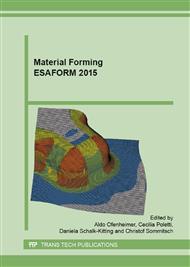p.132
p.138
p.144
p.150
p.156
p.163
p.169
p.175
p.181
Research of Dynamic Recrystallization Processes in Heat-Resistant Ni-Based Alloy
Abstract:
Dynamic recrystallization processes in heat-resistant Ni-based alloy was investigated depending on temperature, strain rate and deformation ratio. Recrystallization intensity is determined by the temperature and deformation conditions. The factors that increase the degree of dynamic recrystallization include temperature and amount of strain increasing, as well as decreasing of strain rate. Increasing the volume fraction of recrystallized structure causes a uniform fine-grained structure.
Info:
Periodical:
Pages:
156-162
Citation:
Online since:
July 2015
Price:
Сopyright:
© 2015 Trans Tech Publications Ltd. All Rights Reserved
Share:
Citation:


